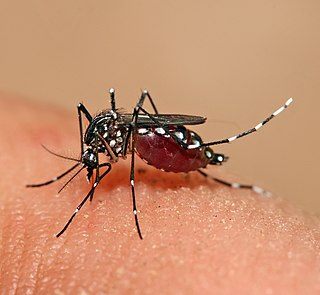Related Research Articles

Aedes is a genus of mosquitoes originally found in tropical and subtropical zones, but now found on all continents except perhaps Antarctica. Some species have been spread by human activity: Aedes albopictus, a particularly invasive species, was spread to the New World, including the United States, in the 1980s, by the used-tire trade.

Toxorhynchites, also called elephant mosquito or mosquito eater, is a genus of diurnal and often relatively colorful mosquitoes, found worldwide between about 35° north and 35° south. Most species occur in forests. It includes the largest known species of mosquito, at up to 18 mm (0.71 in) in length and 24 mm (0.94 in) in wingspan. It is among the many kinds of mosquito that do not consume blood. The adults subsist on carbohydrate-rich materials, such as honeydew, or saps and juices from damaged plants, refuse, fruit, and nectar.

Chaoborus is a genus of midges in the family Chaoboridae. The larvae are known as glassworms because they are transparent. They can be found commonly in lakes all over the world and can be up to 2 cm (0.8 in). The adults are sometimes called phantom midges or lake flies.
Stegomyia is a large subgenus of the mosquito genus Aedes with 131 species classified in six species groups, two groups of which are further divided into subgroups.

Ochlerotatus is a genus of mosquito. Until 2000, it was ranked as a subgenus of Aedes, but after Reinert's work, the clade was upgraded to the level of a genus. This change has resulted in the renaming of many subgenus species, and many aedini-related taxa are undergoing taxonomic revisions. Some authors are still using traditional taxonomic names in their publications.
Haemagogus is a genus of mosquitoes in the dipteran family Culicidae. They mainly occur in Central America and northern South America, although some species inhabit forested areas of Brazil, and range as far as northern Argentina. In the Rio Grande Do Sul area of Brazil, one species, H. leucocelaenus, has been found carrying yellow fever virus. Several species have a distinct metallic sheen.

Anopheles is a genus of mosquitoes (Culicidae). Of about 484 recognised species, over 100 can transmit human malaria, but only 30–40 commonly transmit parasites of the genus Plasmodium that cause malaria, which affects humans in endemic areas. Anopheles gambiae is one of the best known, because of its predominant role in the transmission of the deadly species Plasmodium falciparum.
Mansonia mosquitoes are big, black or brown mosquitoes with sparkling on their wings and legs. They breed in ponds and lakes containing certain aquatic plants, especially the floating type like Pistia stratiotes and water hyacinth. The eggs are laid in star-shaped clusters on the undersurface of leaves of these plants. The larvae and pupae are found attached to the rootlets of these plants by their siphon tubes. They obtain their air supply from these rootlets. When about to become adult, these pupae come to the surface of water and the fully formed adults emerge and escape. The control of Mansonia mosquitoes is easy by removal or destruction of the aquatic host plants by herbicides.
Pseudoficalbia is a subgenus of the mosquito genus Uranotaenia with 146 species. It was originally created as a genus by Frederick Vincent Theobald in 1911 ; however, it was later treated as a subgenus of Uranotaenia, and then was made a synonym of the same genus. It was later restored as a subgenus by E.L. Peyton in 1972.
Uranotaenia is a subgenus of the mosquito genus Uranotaenia with 121 species:
The Afrotropical mosquito genus Eretmapodites contains species that exhibit facultative cannibalism in their larval developmental stages. The species was first described in 1901 by Frederick Vincent Theobald. The type species is Eretmapodites quinquevittatus Theobald

Sabethes mosquitoes are primarily an arboreal genus, breeding in plant cavities. The type species is Sabethes locuples, first described by Jean-Baptiste Robineau-Desvoidy in 1827.
Orthopodomyia is a genus of mosquitoes in the family Culicidae. There are at least 40 described species in Orthopodomyia.
Deinocerites is a genus of mosquitoes in the family Culicidae. There are about 18 described species in Deinocerites.
Armigeres is a genus of mosquito belonging to the family Culicidae.
References
- 1 2 "Uranotaenia Report". Integrated Taxonomic Information System. Retrieved 2018-05-04.
- 1 2 "Browse Uranotaenia". Catalogue of Life. Retrieved 2018-05-04.
- 1 2 "Uranotaenia". GBIF. Retrieved 2018-05-04.
- 1 2 "Uranotaenia Genus Information". BugGuide.net. Retrieved 2018-05-04.
- ↑ Calisher, Charles H.; Higgs, Stephen (2018-01-07). "The Discovery of Arthropod-Specific Viruses in Hematophagous Arthropods: An Open Door to Understanding the Mechanisms of Arbovirus and Arthropod Evolution?". Annual Review of Entomology . Annual Reviews. 63 (1): 87–103. doi:10.1146/annurev-ento-020117-043033. ISSN 0066-4170.